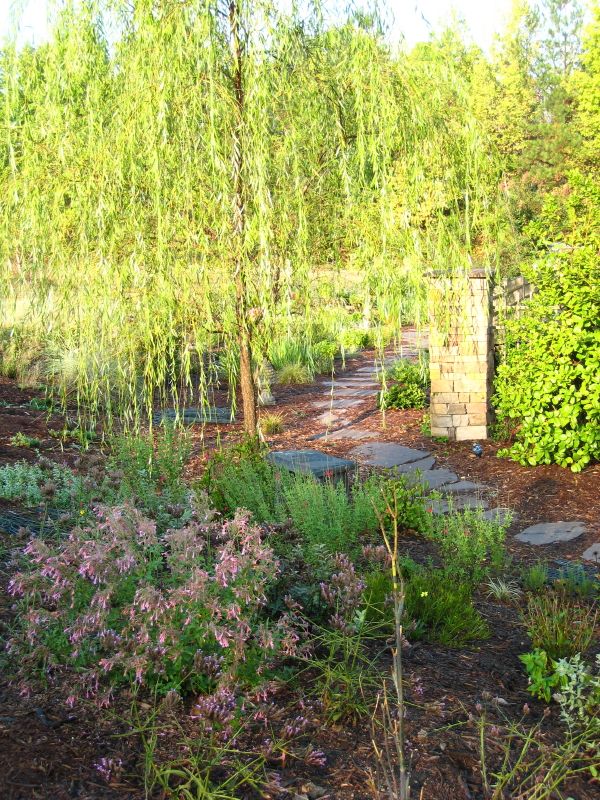To truly enjoy a garden, I believe you must go out and get IN the garden rather than view it from afar. As spring emerges, I find plants changing within only a few hours. In my mind, I start re-arranging the garden; I look at the health or attractiveness (or lack of) among the current plants; I think about the colors or kinds of plants that I want to increase or decrease.
Rather than keep a written journal, I tend to document the garden through photographs. Right now, I can go back to last year's photos to help me remember how the perennials, ornamental grasses and annuals looked.
To allow us to stroll the garden, the entire family has participated in the creation of paths, points of interest and plantings. Although the outer garden was just established in 2007, the feeling of a garden structure was obvious early on.
To provide perspective, the outer garden is outside the fence in the front (south) and east side of the house. To the left is our dry stream bed with a little arched bridge to the meadow. To the right, the path cuts back to the side of the house, through the butterfly garden; the path then leads past the back of our waterfall, then to the fragrance garden, a patio and the pool behind the house.

All of the following garden path photos were taken in September 2007, when much of the garden blooms had already peaked. We are still in extreme drought. At the time the photos were taken, we were in the middle of an exceptional drought (worse). We had just experienced a brief rain that provided a nice color for the dried out mulch.
This is the path in front of the fence. Plants that tolerate moisture are planted along the left side of the stepping stones as the rain runoff from the meadow drains here. Then, the rain runoff slowly drains to the far end of this path to the dry stream bed.

Along the front path, we have little points of interest such as the sundial and the acorn finial.


This is a view of the dry stream bed from the front garden stepping stones.

This is a view of the dry stream bed taken from the driveway, looking back toward the front garden.

From this view, you can see the willow tree (bench below) looking from the butterfly garden to the corner turn into the front garden. The willow was planted in the fall 2005 when the house was built. It benefits from the water runoff from the meadow above. In the forground, there are stripped stems of bronze fennel that served as a host plant for swallowtail butterflies. Behind the bench is a mass planting of salvia greggii 'Navajo Red' which serves up hummingbird nectar. Those salvia are evergreen here in NC and are like small shrubs (3x3) when mature.

Moving backward in the butterfly garden (on the left), the birdbath is actually serving as a butterfly beach. In the summer, we add sand (keep it moist) and a touch of salt for the butterflies. The chaste tree on the left is a favorite. It is surrounded by agastache, asclepias tuberosa (host plant for Monarchs), coneflowers, coreopsis, crocosmia, nepeta, pineapple sage (for hummingbirds), rubeckia, verbena and a few ornamental grasses (miscanthus, clumping bamboo). On the right side are hollies (bees love those when they bloom in spring), osmanthus fragrans, lilac, baptisia, monarda, nepeta and other ornamental shrubs and perennials. When the perennials are in bloom, this area has a bright look with orange, red, blue, purple, and yellow.


A Red-banded Hairstreak pauses on the vitex (chaste tree):

A Monarch enjoys the agastache 'Blue Fortune':

Turning around in the butterfly garden to look toward the back of the house, the garden path winds around behind the waterfall (mound is planted with cryptomeria, cotoneaster, and ornamental grasses). The path leads to the fragrance garden.

The fragrance garden is planted with sweet bay magnolia, gardenia, ginger, akebia, jasmine, buddleia, willow, monarda, osmanthus fragrans, colocasia, brugmansia and heuchera. The green, lush foliage and evening fragrance makes for a wonderful dining patio (family built). The arbor, covered with akebia and jasmine, leads to the pool and deck in the backyard.

I hope you enjoyed the garden promenade. As the growing season progresses and there is color in the garden, I'll post a follow-up promenade.
Happy Gardening!
Cameron

